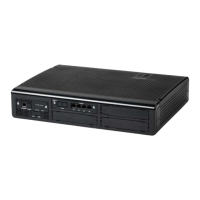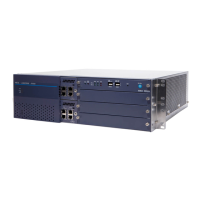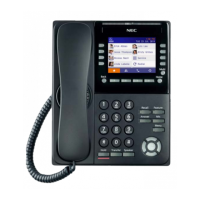CHAPTER 1 INTRODUCTION
UNIVERGE NEAX 2000 IPS General Description Page 20
Issue 5
UNIVERGE NEAX
®
2000 IPS
DMR
The UNIVERGE NEAX IPS
DMR
(Internet Protocol Server Distributed Model Remote) is a
UNIVERGE
NEAX IPS
DML
that has been optimized for Remote PIM over IP applications. The
UNIVERGE
NEAX IPS
DMR
uses the SPN-CP31-D as the Main Processor. This system targets
users who have up to 30 relatively small offices that accommodate 10-30 extensions at the
Remote Site.
The MP card at Remote Site has the same system data as that at Main Site, because Remote Site
automatically gets the data from Main Site at the time of setup. In normal operation, Main Site
automatically copies the system data to Remote Site through the network once a day.
Because the CP31-D is a cost down CPU, the following options that are built-in on the CP24 are
not available with the CP31:
• No built-in DAT.
• Only one RS Port.
• No built-in DK (external/relay key).
•
No MN Alarm Indication
System Outline
• The MP card at Main Site controls system processing, and Remote Site follows the Main
Site.
•
Remote Site can accommodate most terminals and trunks such as Dterm, Single-Line
telephone, PS, DtermIP, COT, ISDN, etc. The Attendant Console, Dterm Attendant
position, and Add-on Module are not supported at the Remote Site.
• Local Switch (TDSW) at Remote Site controls connections within the Remote Site if
possible.
• In the case of connections between Main-Remote and Remote-Remote, the voice path is
connected via Peer-to-Peer or IP-PAD.
•
If the communications between Main-Remote are interrupted, the Remote Site survives
by itself after the system reset.
Advantages
•
The system regards the terminals accommodated in both Main Site and Remote Site as
the extensions in the same office. Therefore, the service transparency is superior to CCIS.
• Remote PIM over IP has no limitation of distance between Main and Remote.
• Remote Site has a switching function at local. This provides the effective configuration
of C.O. line. In addition, the Remote Site can accommodate AP cards. This is an
advantage to accommodate ISDN lines especially.
•
The Remote Site survives by itself even if the link between Main and Remote is
disconnected. Therefore, the impact to users at Remote Site will be smaller if the link
between Main and Remote is disconnected.
• This feature can reduce the bandwidth used on the WAN that is connected to CO lines at
Remote Site, rather than DtermIP at remote location or the Media Converter (MC)
accommodation.

